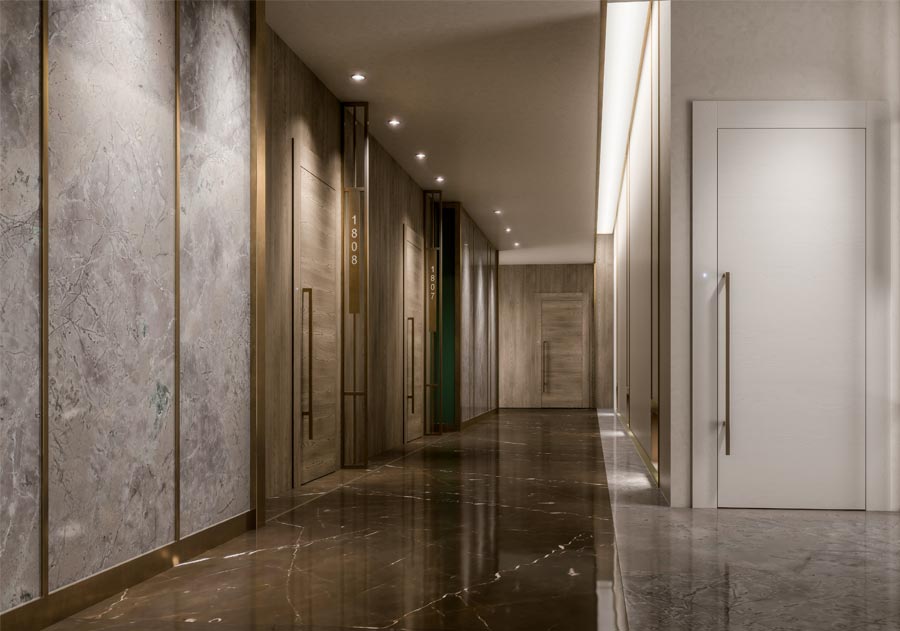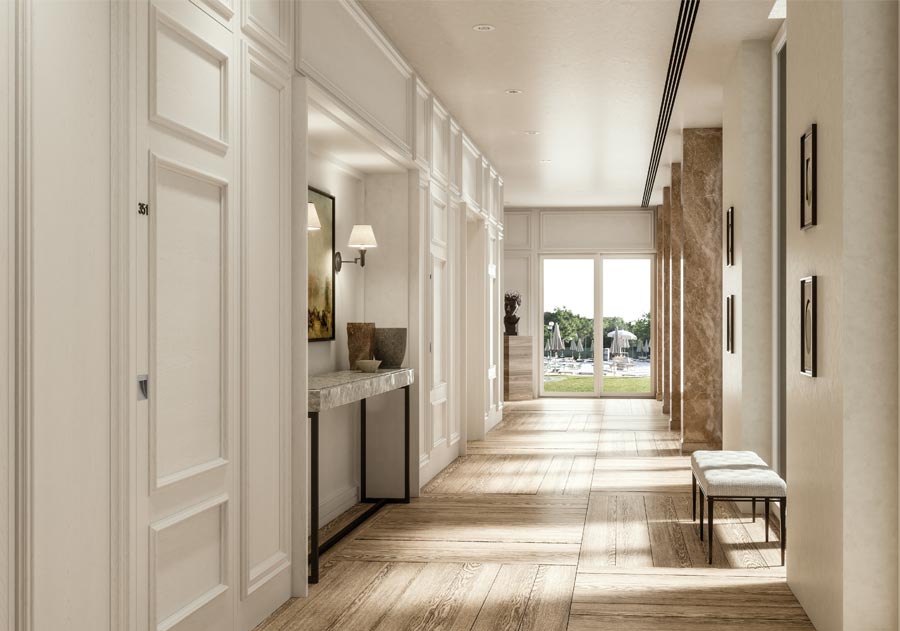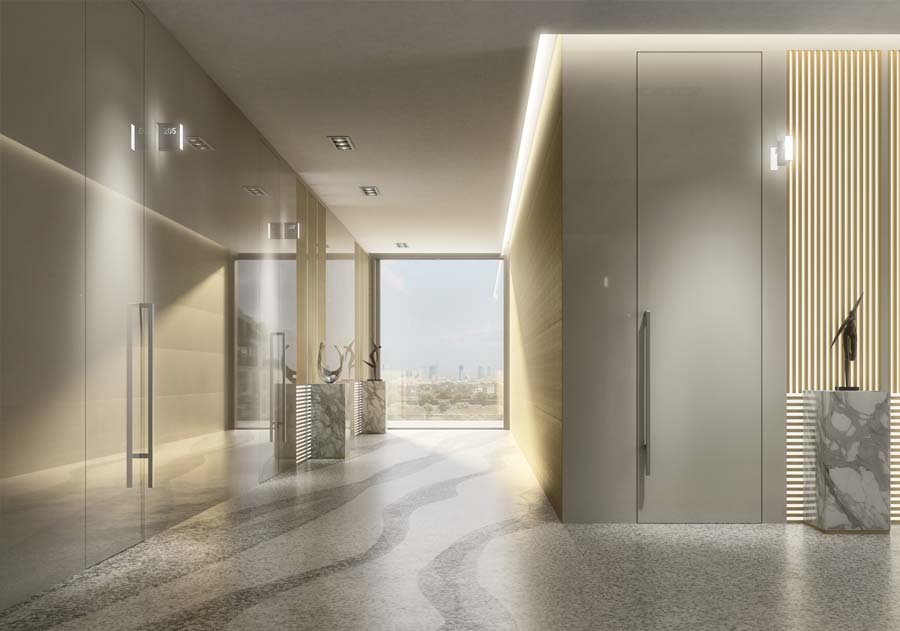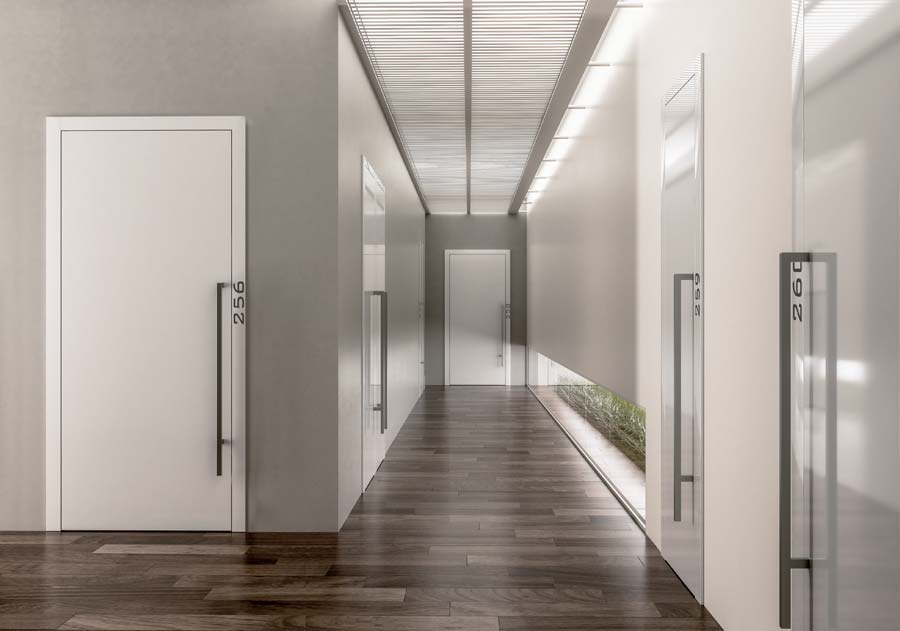| MAGAZINE
Hotel, “Corridor Nightmares”

I don’t think I am wrong if I say that we all remember the famous scene of the little boy – Danny – on the tricycle in front of the Grady twins in the famous film “The Shining” directed by Stanley Kubrik in 1980, based on the equally famous novel by Stephen King.
We find ourselves in a hotel and are confronted with a setting that is as simple as it is distressing, in probably one of the most disturbing scenes in the history of horror cinematography.
In the design of a space, already the perception of a long, narrow space leads to maintaining that degree of tension and movement, in this case accentuated by the tricycle’s pacing; wallpaper and carpeting contribute to the jitteriness of the scene.
What about the doors? As anonymous as possible to also contribute to the tension of the plot, true protagonists of such a space.
Corridor
Nightmares
Yet, how many hotels – real ones – still present such appalling (“sloppy” is perhaps the more appropriate term) images in the corridors and vestibules?
A corridor is an area of transition from point A to point B.
In hotels, it is obviously the distribution system on the floors of all rooms, a “necessary” space dependent on both the conformation of a building and the design of routes and the study of the flows of guests and operators moving within a facility.
The design criteria of a hotel have now evolved on an “emotional” scale, according to which the image proposed in each space must strike the sensory sphere of the people who choose to stay there.
Everything contributes to the guest’s well-being, even the care and detail of the hotel’s spaces, not just the services or the hospitality of the staff. But does this also apply to corridors? If only!
While design attention is focused on rooms or common spaces (lobby, lounge, restaurant, spa, etc.), all too often corridors remain mere passing spaces, perfect candidates for a new TV show like “Corridor Nightmares”.
The Choice
for example
And in this miscalculation, the choice of doors has a very important specific weight, along with all the other elements (such as lights, colors, materials, etc.) that should help make vestibules fascinating communication spaces in which to find the hotel’s concept.
For the time being we are talking about image, without going into the more technical requirements that a door in a hotel must have (soundproofing, security, etc.), which are fundamental for the guest’s well-being and deserve a specific in-depth study.
Read also “Noise in hotels? No thanks”.
When designing a hotel vestibule, the design of a room door should reflect not only the elegance of the facility, but should echo its concept, the basis of the entire offering and the defining aspect of the image of all of the spaces.
Although most of the time the corridor arises primarily out of functional needs, the doors can (and should) help make these pathways – usually narrow and long, sometimes endless – a pleasant journey for the guest.

A question
of style
Choosing or designing the right door starts, of course, with the image of the hotel itself, always in the spirit of maximum consistency of the whole project. Then, no limit to creativity.
Is it a classical style hotel? The door will be a “richer” element, and there will be, perhaps, ashlars, mirrors or frames to characterize the doors and frames, so that the door will participate in the decorative apparatus of the entire corridor.

When should we choose classic doors and with what criteria? It is the subject of a dedicated in-depth study, given the fundamental importance of not falling back on the trite “copy and paste” that would represent a completely anachronistic, not at all elegant choice.
The risk of returning to the “Corridor Nightmares” effect is also high if we go to the diametrically opposite side, that of minimalist design, for which we often opt to achieve a more contemporary feel to the overall image: in this case, the tendency to clean up the forms altogether and eliminate any decorative frills falls into the mundane when it is an end in itself.
It seems obvious, but a look at the corridors in The Shining shows that doors are very much living elements in corridor design, almost more important in these vestibules than in the rooms with which they participate in the overall design and image proposed to guests.
Elements such as lighting, colors, or the choice of how to do the room numbers certainly contribute to the creation of an elegant environment and should certainly be designed as a whole; but if in a corridor we leave the choice of doors to chance, there will be nothing that can save us from a poor result.

Personali-
zation
Whether they are flush with the wall, classical or designer, white in contrast to colored walls or colored in contrast to a more minimalist environment, the advice for any hotel that wants to stand out is to ask architects and designers for an ad hoc product.
Today, the exclusivity of unique elements (not just doors) is crucial in the guest’s assessment of quality.
Our hotel door collections offer the perfect combination of customizable design and impeccable technical features, a guarantee for meeting all requirements in the specific hotel context.
In this area, the concept of “standard” must be banished: guests also choose a particular hotel because of the authenticity with which it conveys certain emotions to them.
Thus, even in the choice of doors – as well as that of room design, colors, materials – aiming for customization means getting closer and closer to the needs of guests while making the accommodation unique.
Once upon a time, making something specific involved a huge expenditure in terms of resources and economics: today, thanks to the evolution of technology, it is possible to come up with ad hoc products while maintaining the simplicity of the construction process.
For this reason, thanks also to the wide choice of materials, the possibility of customization, makes it possible to meet not only the needs of luxury or otherwise high-end hotels, but to aim for elegance and quality even in the case of lower targets, without the need to deviate from the essential features and requirements, whether functional or formal.
No more anonymous or creepy spaces, much less corridor nightmares: we do not allow ourselves to be conditioned only by the functionality of these rooms, and we make sure that the guest feels as accompanied to his or her room on a journey that is as fascinating and emotional as the others in which we invite him or her to stay.

| GET IN TOUCH
For more information, please fill in the form.

